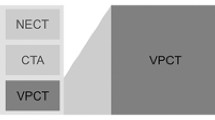Abstract
The influence of the frequency of computed tomography (CT) image acquistion on the diagnostic quality of dynamic perfusion CT (PCT) studies of the brain was investigated. Eight patients with clinically suspected acute ischemia of one hemisphere underwent PCT, performed on average 3.4 h after the onset of symptoms. Sixty consecutive images per slice were obtained with individual CT images obtained at a temporal resolution of two images per second. Eight additional data sets were reconstructed with temporal resolutions ranging from one image per second to one image per 5 s. Cerebral blood flow (CBF), cerebral blood volume (CBV) and mean transit time (MTT) measurements were performed in identical regions of interest. Two neuroradiologists evaluated the PCT images visually to identify areas of abnormal perfusion. Perfusion images created up to a temporal resolution of one image per 3 s were rated to be diagnostically equal to the original data. Even at one image per 4 s, all areas of infarction were identified. Quantitative differences of CBF, CBV and MTT measurements were ≤10% up to one image per 3 s. For PCT of the brain, temporal resolution can be reduced to one image per 3 s without significant compromise in image quality. This significantly reduces the radiation dose of the patient.





Similar content being viewed by others
References
Latchaw RE, Yonas H, Hunter GJ, Yuh WT, Ueda T, Sorensen AG, Sunshine JL, Biller J, Wechsler L, Higashida R, Hademenos G, Council on Cardiovascular Radiology of the American Heart Association (2003) Guidelines and recommendations for perfusion imaging in cerebral ischemia: a scientific statement for healthcare professionals by the writing group on perfusion imaging, from the council on cardiovascular radiology of the American Heart Association. Stroke 34:1084–1104
Mayer TE, Hamann GF, Baranczyk J, Rosengarten B, Klotz E, Wiesmann M, Missler U, Schulte-Altedorneburg G, Brueckmann HJ (2000) Dynamic CT perfusion imaging of acute stroke. AJNR Am J Neuroradiol 21:1441–1449
Wiesmann M, Bohner G, Klingebiel R (2004) Cerebral perfusion imaging using multislice computed tomography. Clin Neuroradiol 14:92–107
Wiesmann M, Meyer K, Albers T, Seidel G (2004) Parametric perfusion imaging with contrast-enhanced ultrasound in acute ischemic stroke. Stroke 35:508–513
Wintermark M, Bogousslavsky J (2003) Imaging of acute ischemic brain injury: the return of computed tomography. Curr Opin Neurol 16:59–63
Wintermark M, Maeder P, Verdun FR, Thiran JP, Valley JF, Schnyder P, Meuli R (2000) Using 80 kVp versus 120 kVp in perfusion CT measurement of regional cerebral blood flow. AJNR Am J Neuroradiol 21:1881–1884
Fleischmann D, Rubin GD, Bankier AA, Hittmair K (2000) Improved uniformity of aortic enhancement with customized contrast medium injection protocols at CT angiography. Radiology 214:363–371
König M (2003) Brain perfusion CT in acute stroke: current status. Eur J Radiol 45:S11–S22
Wintermark M, Smith WS, Ko NU, Quist M, Schnyder P, Dillon WP (2004) Dynamic perfusion CT: Optimizing the temporal resolution and contrast volume for calculation of perfusion CT parameters in stroke patients. AJNR Am J Neuroradiol 25:720–729
Kämena A, Streitparth F, Grieser C, Lehmkuhl L, Jamil B, Wojtal K, Ricke J, Pech M (2007) Dynamic perfusion CT: Optimizing the temporal resolution for the calculation of perfusion CT parameters in stroke patients. Eur J Radiol 64:111–118
Nambu K, Takehara R, Terada T (1996) A method of regional cerebral blood perfusion measurement using dynamic CT with an iodinated contrast medium. Acta Neurol Scand Suppl 166:28–31
Wintermark M, Reichhart M, Thiran JP, Maeder P, Chalaron M, Schnyder P, Bogousslavsky J, Meuli R (2002) Prognostic accuracy of cerebral blood flow measurement by perfusion computed tomography, at the time of emergency room admission, in acute stroke patients. Ann Neurol 51:417–432
Wintermark M, Maeder P, Verdun FR, Thiran JP, Valley JF, Schnyder P, Meuli R (2000) Using 80 kVp versus 120 kVp in perfusion CT measurement of regional cerebral blood flow. AJNR Am J Neuroradiol 21:1881–1884
Imanishi Y, Fukui A, Niimi H, Itoh D, Nozaki K, Nakaji S, Ishizuka K, Tabata H, Furuya Y, Uzura M, Takahama H, Hashizume S, Arima S, Nakajima Y (2005) Radiation-induced temporary hair loss as a radiation damage only occurring in patients who had the combination of MDCT and DSA. Eur Radiol 15:41–46
Author information
Authors and Affiliations
Corresponding author
Rights and permissions
About this article
Cite this article
Wiesmann, M., Berg, S., Bohner, G. et al. Dose reduction in dynamic perfusion CT of the brain: effects of the scan frequency on measurements of cerebral blood flow, cerebral blood volume, and mean transit time. Eur Radiol 18, 2967–2974 (2008). https://doi.org/10.1007/s00330-008-1083-x
Received:
Revised:
Accepted:
Published:
Issue Date:
DOI: https://doi.org/10.1007/s00330-008-1083-x




